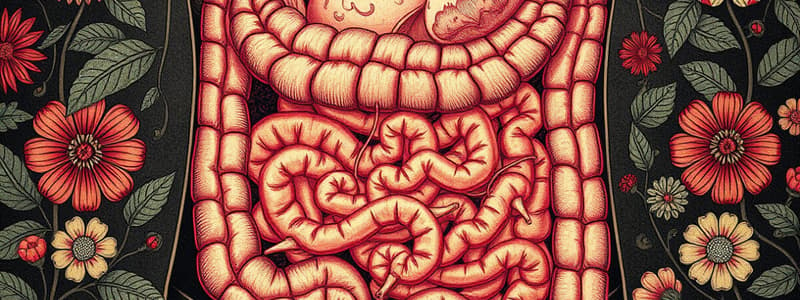Podcast
Questions and Answers
What characterizes the parietal peritoneum in terms of pain sensation?
What characterizes the parietal peritoneum in terms of pain sensation?
- Pain is only sensed upon inflammation.
- Pain is poorly localized and difficult to identify.
- Pain is well-localized to the overlying dermatome. (correct)
- Pain can only be sensed in the presence of visceral injury.
Which of the following folds extends from the inferior curvature of the stomach to the transverse colon?
Which of the following folds extends from the inferior curvature of the stomach to the transverse colon?
- Lesser omentum
- Mesentery
- Greater omentum (correct)
- Falciform ligament
Which artery primarily supplies the structures of the embryologic foregut?
Which artery primarily supplies the structures of the embryologic foregut?
- Celiac trunk (correct)
- Superior mesenteric artery
- Renal artery
- Inferior mesenteric artery
What is the primary function of the mesentery in the gastrointestinal tract?
What is the primary function of the mesentery in the gastrointestinal tract?
What does the peritoneal cavity include in terms of compartments?
What does the peritoneal cavity include in terms of compartments?
What is the primary function of the hepatic portal vein?
What is the primary function of the hepatic portal vein?
Which veins combine to form the hepatic portal vein?
Which veins combine to form the hepatic portal vein?
Where does the blood flow after leaving the liver?
Where does the blood flow after leaving the liver?
What is the sequence of blood flow through the vessels mentioned?
What is the sequence of blood flow through the vessels mentioned?
Which of the following structures does NOT directly contribute to the hepatic portal circulation?
Which of the following structures does NOT directly contribute to the hepatic portal circulation?
Flashcards are hidden until you start studying
Study Notes
General Anatomy of the Abdomen
- The abdomen is part of the trunk, bordered by the diaphragm, musculo-aponeurotic walls, pelvic inlet, and vertebrae.
- The abdominal cavity contains the alimentary canal and accessory organs.
General Contents of the Abdominal Cavity
- Alimentary Canal: Lower esophageal sphincter, stomach, small intestine (duodenum, jejunum, ileum), and large intestine (cecum, ascending colon, transverse colon, descending colon).
- Accessory Organs: Liver, gallbladder, pancreas, spleen, kidneys, and peritoneal structures including vessels and nerves.
Peritoneum & Peritoneal Cavity
- Peritoneum: A transparent, thin membrane lining the abdominopelvic cavity, continuous with serosa of organs.
- Parietal Peritoneum: Lines body walls, well-localized pain, sensitive to various stimuli.
- Visceral Peritoneum: Covers visceral organs, less localized pain, important in sensing ischemia and inflammation.
- Major folds include mesenteries and omenta, aiding in positioning and vascularity of abdominal structures.
Major Peritoneal Folds
- Greater Omentum: A large apron-like fold extending from the stomach to the abdominal wall, rich in fat and lymph nodes, mobilizes to wrap around inflamed organs.
- Lesser Omentum: Connects the liver to the stomach and duodenum; contains important vascular structures like the hepatic artery, bile duct, and portal vein.
- Mesentery: Connects the small intestine to the posterior abdominal wall, housing vessels and nerves.
- Mesocolon: Similar function for the large intestine.
Anatomical Features of the Peritoneal Cavity
- Retroperitoneal structures: Parts of the duodenum, pancreas, kidneys, adrenal glands, and major blood vessels are not fully surrounded by peritoneum.
- Clinical relevance of peritoneal sacs: The omental bursa is a common area for surgical access.
Abdominal Arterial Vasculature
- Celiac Trunk: Supplies the foregut (liver, stomach, pancreas, and spleen).
- Superior Mesenteric Artery: Supplies midgut structures, including the small intestine and parts of the large intestine.
- Inferior Mesenteric Artery: Supplies hindgut structures and the superior anus.
Abdominal Venous Vasculature
- Portal circulation carries nutrient-rich blood from the digestive organs to the liver.
- Hepatic portal vein formed by the splenic and superior mesenteric veins, important for detoxifying blood.
General GI Tract Histology
- Four main layers:
- Mucosa: Involved in absorption and secretion; lined with epithelial cells.
- Submucosa: Contains blood vessels and nerves.
- Muscularis: Smooth muscle for propulsion and movement.
- Serosa/Adventitia: Connective tissue providing structure.
Histological Features of Various GI Organs
- Esophagus: Non-keratinized stratified squamous epithelium, with areas of mucous-secreting glands and muscular transitions.
- Stomach: Simple columnar epithelium with glands for acid secretion, featuring a unique three-layer muscularis.
- Small Intestine: Highly folded mucosa (plicae circulares, villi, microvilli) optimized for absorption, with Peyer's patches in the ileum.
- Large Intestine: Simple columnar epithelium, with a greater number of goblet cells and unique teniae coli, reflecting its function in water absorption and defecation.
Enteroendocrine Cells
- Found throughout the GI tract, particularly in the stomach and small intestine, these cells produce hormones crucial for digestion and regulatory functions.
- Types of hormones produced include gastrin, CCK, secretin, and others, each with specific stimuli and functions related to digestion and metabolism.
Peritoneal Membrane Insights
- The peritoneal membrane covers a surface area similar to skin but contains minimal peritoneal fluid, facilitating absorption through venous pores and lymphatic capillaries.
- Ascites refers to the abnormal accumulation of fluid in the peritoneal cavity, often due to inflammation or disease.
Summary
- Understanding the morphological and functional aspects of the GI tract and its supporting structures is crucial for clinical applications, especially in surgery and digestive health.
Studying That Suits You
Use AI to generate personalized quizzes and flashcards to suit your learning preferences.




